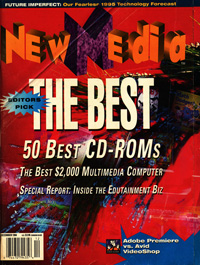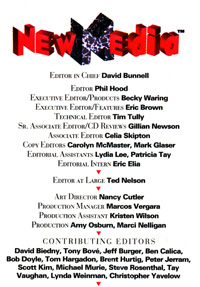|
Vaughan Family Timestream® Maps |
| Home Biography People Places Multimedia: Making It Work On the Water Writings/Presentations |
Ask the Captain
March, 1993
From "Ask the Captain," a monthly column by Tay Vaughan.
New Media Magazine.
Q. Are there any multimedia associations or user groups?
-- Jim Frick, Austin, TX
A. The Interactive Multimedia Association is a non-profit international trade association that represents users, application developers, software suppliers, hardware manufacturers, system integrators, publishers, and distributors. IMA publishes a bimonthly newsletter, Interactive Multimedia News, and has brought Apple, IBM, Compaq, DEC, Kodak, Intel, Lotus, Microsoft, Philips, Roland, Sony, Sun, and other major industry players to the same table (the Compatibility Project) to develop technical solutions that will allow portability of multimedia applications and content across different platforms. Contact the IMA at 3 Church Circle, Suite 800, Annapolis, MD 21401 (410-626-1380) for a membership application package.
The International Interactive Communication Society is a membership-oriented professional association serving the needs of multimedia developers around the world. It has 25 local chapters and represents more than 2000 developers. Local chapters of the IICS organize regular meetings that focus on relevant multimedia topics and issues and include guest speakers. Contact the IICS at P.O. Box 1655, Palo Alto, CA 94301-1655 (415-328-7318).
In December, 1992, the San Francisco Multimedia Development Group was formed as a trade group of more than 75 companies and organizations to foster San Francisco as the international creative center of the multimedia industry. The City's Board of Supervisors has provided official support for building an infrastructure and promoting multimedia. Members of this new group include developers, publishers, corporations, educational institutions, and hardware and software manufacturers. For more information, contact Tim Boyle at 415-546-9756.
The Boston Computer Society (BCS) boasts more than 30,000 members from around the world and has over 50 different user and special interest groups that offer monthly meetings, newsletters, special publications, software, electronic bulletin boards, educational programs, and other services. The Hypermedia/Optical Disk user group of BCS publishes a meaty newsletter. Contact The Boston Computer Society, One Kendall Square, Cambridge MA 02139 (617-252-0600 X3316).
The Multimedia Special Interest Group of the Berkeley Macintosh User Group (BMUG) meets at BMUG's offices on the second Monday of each month (2055 Center Street, Berkeley, CA 94709). This SIG offers new product demonstrations by vendors and rap sessions on imaging, graphics, and desktop video. It is a multi-platform group (PC, Sun, Atari, and Amiga users welcome), and is oriented toward beginners.. Call (510-849-9114) for meeting details.
Other user groups are often supported and maintained by software and hardware vendors. For example, the well-attended Macromedia User Forum meets monthly at the San Francisco offices of Macromedia, makers of Director, Authorware, MacRecorder, SoundEdit, and other multimedia tools. If you are interested in learning more about a particular product, call that product's manufacturer to find out about user groups and meetings local to your area.
Finally, there are Special Interest Groups on CompuServe, America OnLine, and other electronic bulletin boards where users can share experiences, problems, and solutions with colleagues from around the world. On CompuServe, type GO MULTIMEDIA from the command prompt for an overview of the many forums and conferences available. On America OnLine, check out the Computing & Software Department. Sometimes you can post a question on these services and receive answers from other members within just a few minutes!
Q. What is the CD-Bridge format?
-- Sandy Elkhorn, Madison, WI
A. The digital data contained on a compact disc track may be written in any of several different formats. There is a format for CD-Audio, another for ISO 9660 (DOS, Windows and Macintosh), another for Macintosh HFS, and still other formats for Sony's Extended Architecture (XA), Philips' CD-I, and for Kodak's multisession Photo CD.
CD-Bridge discs are specifically designed to accommodate Philips' CD-I proprietary player system, and the format conforms to both the CD-I and CD-ROM/XA specifications. This format assigns two separate disc label locations, thus allowing a CD-ROM/XA track to be played on a CD-I player. Kodak Photo CD discs can be played on a Philips CD-I player because they are bridge discs.
Also of interest, a CD-I-Ready disc is a CD-Audio disc with special information stored in the pre-gap just before the start of Track 1. These discs are designed specifically to work with Philips CD-I players, and allow pictures and text to be loaded into the player's memory before beginning to play the audio tracks. Because the image data have already been read from the disc and stored in memory, you can view pictures MTV-style while stereo music is played.
For a free booklet and comprehensive technical literature describing the terminology, uses, and structures of the many data formats for making CD-ROMs, contact Disc Manufacturing Inc. at 800-433-3475.
---
Q. At our school, we have eighteen older PCs with 16-color VGA monitors and only two with super-VGA. What's the best way to show 256-color super-VGA images (photographs of our students) on our 16-color VGA monitors?
-- Glen Merriweather, Allston, MA
A. The bad news is that no sixteen colors can satisfactorily display a photorealistic image. The best solution is to raise sufficient funds to upgrade your hardware. In the meantime, try converting your project and its VGA images to grayscale. This will relieve startling color clashes, and the result will be more professional-looking, less like a cartoon, and easier on the eyes.

